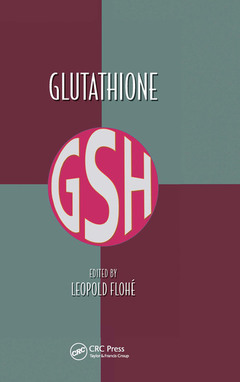Glutathione Oxidative Stress and Disease Series
Coordonnateur : Flohe Leopold

This is the first serious attempt to synthesize all that became known of glutathione over the last three decades. The book contains an update of glutathione biosynthesis with special emphasis on its regulation in adaptive stress responses. Other chapters review glutathione transport systems and glutathione peroxidases and their differences in substrate specificities and localization. Further contributions center on the diversified roles of different glutathione-S-transferases and the roles of nitrosoglutathione and glutaredoxins - a subfamily of redoxins. The book closes with discussions of the analogous or homologous thiol metabolism in pathogens and the potential suitability of involved enzymes as drug targets.
Key selling features:
- Summarizing the way glutathione is involved in stress responses
- Compiling the multiple ways glutathione affects inflammatory responses
- Disclosing how glutathione dampens programmed cell death such as ferroptosis
- Exploring the enigma of how enzymes accelerate glutathione-dependent processes
- Discussing how detoxification and redox regulation is mediated by glutathionylation
- Reviewing the ways glutaredoxins catalyze protein disulfide reduction
- Highlighting the medical impact of glutathione-related metabolic pathways
- Illustrating the role thiol metabolism of pathogens might play in drug discovery
Contents
Series Preface.............................................................................................................xi
Editor’s Preface....................................................................................................... xiii
Editor Biography......................................................................................................xix
List of Contributors .................................................................................................xxi
Part I Biosynthesis, Compartmentation,
and Transport of Glutathione
Chapter 1 Biosynthesis of Glutathione and Its Regulation....................................3
Henry Jay Forman, Hongqiao Zhang, and Terrance J. Kavanagh
Chapter 2 Renal Glutathione Transport Systems: Roles in Redox
Homeostasis, Cytoprotection, and Bioactivation................................ 35
Lawrence H. Lash
Part II Glutathione-Dependent
Hydroperoxide Metabolism
Chapter 3 The Catalytic Mechanism of Glutathione Peroxidases....................... 53
Laura Orian, Giorgio Cozza, Matilde Maiorino, Stefano
Toppo, and Fulvio Ursini
Chapter 4 GPx1-Dependent Regulatory Processes in Health and Disease......... 67
Diane E. Handy and Joseph Loscalzo
Chapter 5 Glutathione Peroxidase 1 as a Modulator of Insulin Production
and Signaling: Implications for Its Dual Role in Diabetes................. 81
Holger Steinbrenner and Lars-Oliver Klotz
Chapter 6 GPx2 Role in Physiology and Carcinogenesis....................................95
Anna P. Kipp
Chapter 7 GPx4: From Prevention of Lipid Peroxidation to
Spermatogenesis and Back................................................................ 111
Matilde Maiorino, Antonella Roveri, and Fulvio Ursini
Chapter 8 Thiols, Glutathione, GPx4, and Lipid Metabolism at the
Crossroads of Cell Death and Survival............................................. 129
José Pedro Friedmann Angeli, Valerian E. Kagan, and Marcus
Conrad
Chapter 9 Peroxiredoxin 6 as Glutathione Peroxidase...................................... 143
Yefim Manevich
Chapter 10 Glutathione Peroxidases and the Thyroid Gland.............................. 161
Lutz Schomburg
Part III Conjugations and Isomerizations
Chapter 11 Glutathione Transferases: From the Test Tube to the Cell................ 175
Bengt Mannervik and Birgitta Sjödin
Chapter 12 Protein S-glutathionylation and Glutathione S-transferase P............ 201
Kenneth D. Tew
Chapter 13 The Role of Glutathione in Biosynthetic Pathways and
Regulation of the Eicosanoid Metabolism........................................ 215
Ralf Morgenstern, Leopold Flohé, Jesper Z. Haeggström, and
Per-Johan Jakobsson
Chapter 14 Nitric Oxide and S-Nitrosoglutathione..............................................227
Iain L. O. Buxton and Scott D. Barnett
Part IV The Glutaredoxins
Chapter 15 The Catalytic Mechanism of Glutaredoxins..................................... 251
Linda Liedgens and Marcel Deponte
Chapter 16 The Role of Glutaredoxins in the Brain............................................263
Carsten Bernd, Anna Dorothee Engelke, Klaudia Lepka, and
Lars Bräutigam
Part V Glutathione Derivatives and
Substitutes in Pathogenic Microorganisms
Chapter 17 Biosynthesis of Polyamine–Glutathione Derivatives in
Enterobacteria and Kinetoplastida...................................................285
Marcelo A. Comini
Chapter 18 Trypanothione Functions in Kinetoplastida......................................307
Martín Hugo, Madia Trujillo, Lucía Piacenza, and Rafael Radi
Chapter 19 Mycothiol, a Low-Molecular-Weight Thiol Drafted for
Oxidative Stress Defense Duty......................................................... 331
Leonardo Astolfi Rosado, Brandán Pedre, and Joris Messens
Chapter 20 Biosynthesis and Functions of Bacillithiol in Firmicutes................. 357
Quach Ngoc Tung, Nico Linzner, Vu Van Loi,
and Haike Antelmann
Index....................................................................................................................... 379
Leopold Flohé is Professor at the Universidad de la Republica Uruguay in Montevideo, Uruguay. He also Distinguishing Visiting Professor in the Department of Molecular Medicine at the University of Padova in Italy. He has been recognized by PubMed.gov as a Redox Pioneer because has published an article on antioxidant/redox biology, as first author, that has been cited more than 1,000 times, and more than 20 articles have been cited more than 100 times. He obtained the medical doctorate at the Institute of Pharmacology and Toxicology at the University of Tübingen, Germany, in 1968. He held positions in both Academia (Tübingen, Aachen, and Braunschweig, Germany) and industry (Aachen). He is now operating the biotech company MOLISA in Magdeburg, Germany, while teaching as guest professor at the local university. Dr. Flohé is the pioneer who established the selenoprotein nature of glutathione peroxidase (GPx), the first and, for almost 10 years, the only selenoprotein known in animals. His work was pivotal to link the essential trace element selenium to metabolic processes, which led the Food and Drug Administration (FDA) to approve selenium supplementation for humans in 1980, and stimulated selenium biochemistry in general. In recent years, he embarked on investigating how pathogens protect themselves from oxidative killing. His studies on the thiol-dependent hydroperoxide metabolism of trypanosomatids and mycobacteria defined molecular drug targets, paving the way to new therapeutic strategies for neglected diseases affecting the people of developing countries.
Date de parution : 09-2020
15.6x23.4 cm
Date de parution : 10-2018
15.6x23.4 cm
Thèmes de Glutathione :
Mots-clés :
Protein Tyrosine Phosphatase 1B; LMW Thiol; GPx4 Expression; Active Site Cysteine; GPx1 mRNA; Thiol Disulfide Exchange Reactions; FeS Clusters; GCL Activity; GPx1 KO; GPx1 Activity; Mixed Disulfide; Iron Sulfur Clusters; Labile Iron Pool; Thiol Disulfide Oxidoreductases; GCLC Expression; Total GSH Content; GSH Transport; GSH Synthesis; BLM; Iron Dependent Lipid Peroxidation; Mitochondrial GSH; Renal Proximal Tubular Cells; Free GSH; Dual Specificity Protein Phosphatase; PT



